Gibilisco S. Teach Yourself Electricity and Electronics
Подождите немного. Документ загружается.

5. A change of +10 dB in an audio signal represents
(a) a doubling of acoustic power.
(b) a threefold increase in acoustic power.
(c) a tenfold increase in acoustic power.
(d) no change in acoustic power, but a change in frequency.
6. What is the frequency of an acoustic disturbance whose wavelength is 120 mm in air?
(a) 279 Hz
(b) 2.79 kHz
(c) 35.8 Hz
(d) 358 Hz
7. What is the frequency of a sound wave that propagates at a speed of 1100 ft/s?
(a) 33.5 Hz
(b) 335 Hz
(c) 3.35 kHz
(d) Forget it! The frequency of a sound wave is independent of the propagation speed.
8. The relative phase of two acoustic waves from the same source at the same time, one wave
direct and one wave reflected from a wall, can affect
(a) the positions of antinodes and nodes.
(b) the perceived frequency.
(c) the positions of antinodes and nodes, and the perceived frequency.
(d) neither the positions of the antinodes and nodes, nor the perceived frequency.
9. In an acoustic sine wave,
(a) the frequency and phase are identical.
(b) the sound power is inversely proportional to the frequency.
(c) the sound power is directly proportional to the frequency.
(d) all of the sound power is concentrated at a single frequency.
10. Vinyl disks are
(a) susceptible to physical damage.
(b) useful primarily in high-power sound systems.
(c) digital media.
(d) preferred for off-the-air sound recording.
11. If an amplifier introduces severe distortion in the waveforms of input signals, then that
amplifier is
(a) not delivering enough power.
(b) operating at the wrong frequency.
(c) operating in a nonlinear fashion.
(d) being underdriven.
Quiz 551
552 Acoustics, Audio, and High Fidelity
12. Suppose a 10-W amplifier is used with speakers designed for a 100-W amplifier. Which of
the following statements is true?
(a) The speakers are capable of handling the amplifier output.
(b) The amplifier might be damaged by the speakers.
(c) Electromagnetic interference is more likely to occur than would be the case if the speakers
were designed for a 10-W amplifier.
(d) The speakers are likely to produce excessive distortion.
13. Which of the following frequencies cannot be received by an AM/FM tuner?
(a) 830 kHz
(b) 95.7 kHz
(c) 90.1 MHz
(d) 107.3 MHz
14. Which of the following statements about woofers is true?
(a) They are especially useful for reproducing the sounds of barking dogs.
(b) They are designed to handle short, intense bursts of sound.
(c) They should not be used with graphic equalizers.
(d) They are specifically designed to reproduce low-frequency sounds.
15. Suppose you have an amateur radio station and its transmitter causes EMI to your hi-fi
system. Which of the following would almost certainly not help?
(a) Build a new transmitter that works on the same frequencies with the same power output
as your existing transmitter.
(b) Reduce the transmitter output power.
(c) Install shielded speaker wires in the hi-fi system, and be sure the system is well grounded.
(d) Move the amateur radio transmitting antenna to a location farther away from the hi-fi
system.
16. In an analog audio tape recorder/player, the recording head
(a) converts sound waves to radio signals.
(b) converts sound waves to fluctuating electric current.
(c) converts AF current to a fluctuating magnetic field.
(d) converts dc to AF current.
17. A rack-mounted hi-fi system
(a) can save floor space.
(b) is more susceptible to EMI than a compact system.
(c) is cheaper than a compact system.
(d) is designed especially for use with vinyl disks and turntables.
18. An audio mixer
(a) cannot match impedances among interconnected components.
(b) cannot increase the audio output of an amplifier.
(c) eliminates EMI problems in all but the worst cases.
(d) allows a microphone to be used as a speaker.
19. Which of the following devices or circuits ordinarily employs D/A conversion?
(a) A portable CD player
(b) A turntable for use with vinyl disks
(c) An analog audio tape recording/playback system
(d) An RC tone control
20. Which of the following is an advantage of digital audio over analog audio?
(a) Digital media can be used to record and play back audio at higher frequencies than can
analog media.
(b) Multigeneration copies of digital audio programs can be made without degradation in
fidelity, but this is not true of analog audio programs.
(c) Digital audio is compatible with vinyl disks and old-fashioned reel-to-reel and cassette
tape, but analog audio is not.
(d) There are no genuine advantages of digital audio over analog audio. In fact, analog audio
is superior to digital audio in every respect.
Quiz 553
554
32
CHAPTER
Personal and Hobby Wireless
THE TERM WIRELESS AROSE IN THE EARLY 1900S WHEN INVENTORS AND EXPERIMENTERS BEGAN
sending and receiving messages using electromagnetic fields. Gradually, the terminology changed,
and wireless became known as radio, television, and electromagnetic communications. In the 1980s
and 1990s, the term wireless emerged again, this time in a consumer context.
Cellular Communications
Wireless telephone sets are used in a specialized communications system called cellular. Originally,
the cellular communications network was used mainly by traveling business people. Nowadays,
many people regard cell phones as necessities, and some of them come equipped with extra features
such as text messaging, Web browsing, and digital cameras.
How Cellular Systems Work
A cell phone looks like a cross between a cordless telephone receiver and a walkie-talkie, but smaller.
The unit contains a radio transmitter and receiver combination called a transceiver. Transmission
and reception take place on different frequencies, so you can talk and listen at the same time, and
easily interrupt the other party if necessary. This capability is known as full duplex.
In an ideal cellular network, all the transceivers are always within range of at least one repeater.
The repeaters pick up the transmissions from the portable units and retransmit the signals to the
telephone network and to other portable units. The region of coverage for any repeater (also known
as a base station) is called a cell.
When a cell phone is in motion, say in a car or on a boat, the set goes from cell to cell in the
network. This situation is shown in Fig. 32-1. The curved, dashed line is the path of the vehicle.
Base stations (dots) transfer access to the cell phone. This is called handoff. The hexagons show the
limits of the transmission/reception range for each base station. All the base stations are connected
to the regional telephone system. This makes it possible for the user of the portable unit to place
Copyright © 2006, 2002, 1997, 1993 by The McGraw-Hill Companies, Inc. Click here for terms of use.
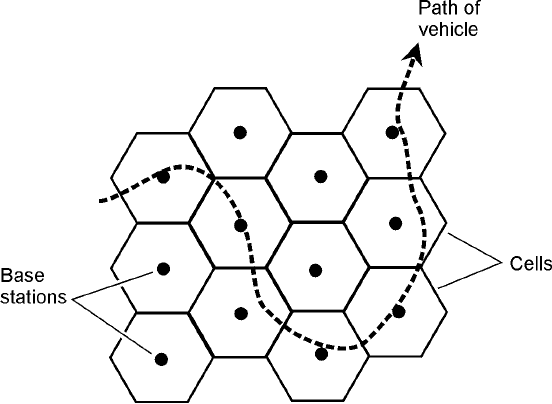
calls to, or receive calls from, anyone else in the system, whether those other subscribers have cell
phones or regular phones.
Older cellular systems occasionally suffer from call loss or breakup when signals are handed off
from one repeater to another. This problem has been largely overcome by a technology called code-
division multiple access (CDMA). In CDMA, the repeater coverage zones overlap significantly, but
signals do not interfere with each other because every phone set is assigned a unique signal code.
Rather than abruptly switching from one base-station zone to the next, the signal goes through a re-
gion in which it is sent through more than one base station at a time. This make-before-break scheme
gets rid of one of the most annoying problems inherent in cellular communications.
In order to use a cellular network, you must purchase or rent a transceiver and pay a monthly
fee. The fees vary, depending on the location and the amount of time per month you use the serv-
ice. When using such a system, it is important to keep in mind that your conversations are not nec-
essarily private. It is easier for unauthorized people to eavesdrop on wireless communications than
to intercept wire or cable communications.
Cell Phones and Computers
You can connect a personal computer (PC) to a cell phone with a portable modem that converts in-
coming computer data from analog to digital form, and also converts outgoing data from digital to
analog form. In this way, you can access the Internet from anywhere within range of a cellular base
station. Figure 32-2 is a block diagram of this scheme.
Most commercial aircraft have telephones at each row of seats, complete with jacks into which
you can plug a modem. If you plan to access the Internet from an aircraft, you must use the phones
provided by the airline, not your own cell phone, because radio transceivers can cause interference
to flight instruments. You must also observe the airline’s restrictions concerning the operation of
electronic equipment while in flight.
Cellular Communications 555
32-1 In an ideal cellular
system, a moving
vehicle is always within
range of at least one
base station.
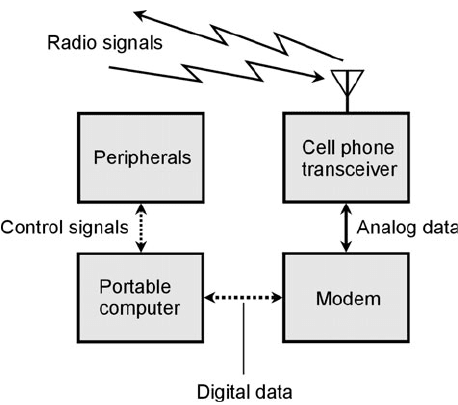
Satellites and Networks
A satellite system is like a huge cellular network with the base stations (repeaters) located in space
rather than on the earth’s surface. The zones of coverage are large, and they change in size and shape
if the satellite moves relative to the earth’s surface.
Geostationary-Orbit Satellites
You learned about geostationary orbits in Chap. 25. Geostationary satellites are used in television
(TV) broadcasting, in telephone and data communication, for gathering weather and environmen-
tal data, and for radiolocation.
In geostationary satellite networks, earth-based stations can communicate through a single
“bird” only when the stations are both on a line of sight with the satellite. If two stations are nearly
on opposite sides of the planet, say in Australia and Wisconsin, they must operate through two satel-
lites to obtain a link (Fig. 32-3). In this situation, signals are relayed between the two satellites, as
well as between either satellite and its respective earth-based station.
A potential problem with geostationary satellite links is the fact that the signal path is long
enough so that perceptible propagation delays occur. This delay, and its observed effect, is known as
latency. This doesn’t cause problems with casual communications or Web browsing, but it slows
things down when computers are linked with the intention of combining their processing power.
Low-Earth-Orbit Satellites
The earliest communications satellites orbited only a few hundred miles above the earth. They were
low-earth-orbit (LEO) satellites. Because of their low orbits, LEO satellites took only about 90 min-
utes to complete one revolution. Communication was spotty, because a satellite was in range of any
given ground station for only a few minutes at a time. This is the main reason why geostationary
satellites became predominant once rocket technology progressed to the point where the necessary
altitude and orbital precision could be obtained.
556 Personal and Hobby Wireless
32-2 A cell phone can be
equipped with a
modem, allowing
portable or mobile
access to online
computer networks.
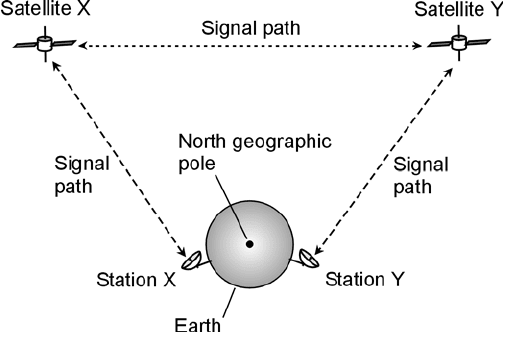
However, geostationary satellites have certain limitations. A geostationary orbit requires con-
stant adjustment, because a tiny change in altitude will cause the satellite to get out of sync with the
earth’s rotation. Geostationary satellites are expensive to launch and maintain. When communicat-
ing through them, there is always a delay because of the path length. It takes high transmitter power,
and a sophisticated, precisely aimed antenna, to communicate reliably. These problems with geosta-
tionary satellites have brought about a revival of the LEO scheme. Instead of one single satellite, the
new concept is to have a large fleet of them.
A good LEO satellite system is launched and maintained in such a way that, for any point on
the earth, there is always at least one satellite in direct line-of-sight range. The satellites can relay
messages throughout the fleet. Thus, any two points on the surface can always make, and maintain,
contact through the satellites. The satellites are placed in polar orbits (routes that pass over or near
the earth’s geographic poles) to optimize the geographical coverage. Even if you’re at or near the
north geographic pole or the south geographic pole, you can use a LEO satellite system. This is not
true of geostationary satellite networks, where the regions immediately around the geographic poles
are not seen by the satellites.
A LEO satellite wireless communications link is easier to access and use than a geostationary
satellite link. A small, simple antenna will suffice, and it doesn’t have to be aimed in any particular
direction. The transmitter can reach the network using only a few watts of power. The latency is less
than 100 milliseconds (ms), compared with as much as 400 ms for geostationary satellite links.
Medium-Earth-Orbit Satellites
Some satellites revolve in orbits higher than those normally considered low-earth, but at altitudes
lower than the geostationary level of 22,300 mi (36,000 km). These intermediate birds are called
medium-earth-orbit (MEO) satellites. A MEO satellite takes several hours to complete each orbit.
MEO satellites operate in fleets, in a manner similar to the way LEO satellites are deployed. Because
the average MEO altitude is higher than the average LEO altitude, each bird can cover a larger re-
gion on the surface at any given time. A fleet of MEO satellites can be smaller than a comparable
fleet of LEO satellites, and still provide continuous, worldwide communications.
The orbits of geostationary satellites are essentially perfect circles, and most LEO satellites orbit
in near-perfect circles. But MEO satellites often have elongated, or elliptical, orbits. The point of
Satellites and Networks 557
32-3 A communications
link that employs two
geostationary satellites.
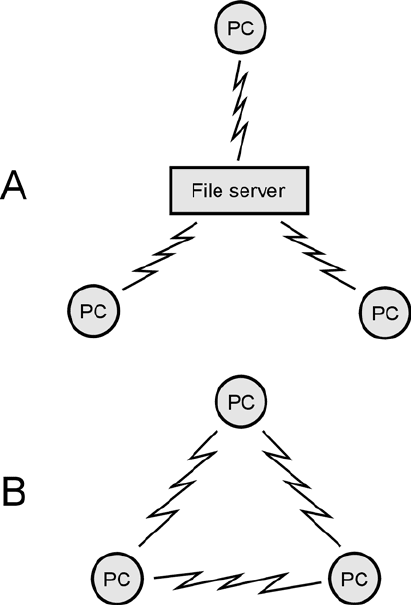
lowest altitude is called perigee; the point of greatest altitude is called apogee. The apogee can be, and
often is, much greater than the perigee. Such a satellite orbits at a speed that depends on its altitude.
The lower the altitude, the faster the satellite moves. A satellite with an elliptical orbit crosses the sky
rapidly when it is near perigee, and slowly when it is near apogee; it is easiest to use when its apogee
is high above the horizon, because then it stays in the visible sky for a long time.
Every time a MEO satellite completes one orbit, the earth rotates beneath it. The rotation of
the earth rarely coincides with the orbital period of the satellite. Therefore, successive apogees for a
MEO satellite occur over different points on the earth’s surface. This makes the tracking of individ-
ual satellites a complicated business, requiring computers programmed with accurate orbital data.
For a MEO system to be effective in providing worldwide coverage without localized periodic black-
outs, the orbits must be diverse, yet coordinated in a precise and predictable way. In addition, there
must be enough satellites so that each point on the earth is always on a line of sight with one or more
of the satellites, and preferably, there should be at least one bird in sight near apogee at all times.
Wireless Networks
A local area network (LAN) is a group of computers linked together within a building, campus, or
other small region. The interconnections in early LANs were made with wire cables, but wireless
links are increasingly common. A wireless LAN offers flexibility, because the computer users can
move around without having to bother with plugging and unplugging cables. This arrangement is
558 Personal and Hobby Wireless
32-4 At A, a client-server
wireless LAN. At B, a
peer-to-peer wireless
LAN.
ideal when notebook computers (also known as laptops) are used. The way in which a LAN is
arranged is called the LAN topology. There are two major wireless LAN topologies: the client-server
wireless LAN and the peer-to-peer wireless LAN.
In the client-server topology (Fig. 32-4A), there is one large, powerful, central computer called
a file server, to which all the smaller personal computers (labeled PC) are linked. The file server has
enormous computing power, high speed, and large storage capacity, and can contain all the data for
every user. End users do not communicate directly. All the data must pass through the file server.
In a peer-to-peer LAN (Fig. 32-4B), all of the computers in the network are PCs with more or
less equal computing power, speed, and storage capacity. Each user maintains his or her own data.
Subscribers can, and almost always do, communicate directly without the data having to pass
through any intermediary. This offers greater privacy and individuality than the client-server topol-
ogy, but it is slower when a large number of users need to share data.
Client-server LANs are favored by large institutions. Small businesses and schools, or depart-
ments within a larger corporation or university, prefer to use peer-to-peer LANs, mainly because
they are cheaper and easier to maintain. In these illustrations, only three PCs are shown in the net-
works. But any LAN can have as few as two, or as many as several dozen, computers.
Home Internet users sometimes employ a modified version of the arrangement shown in Fig. 32-
4A. In place of the file server, a device called a wireless router provides a hub through which the com-
puters can communicate. The router is connected to the Internet by a high-speed interface such as a
cable modem, allowing several computers in a household to have Internet access at the same time.
Amateur and Shortwave Radio
In most countries of the world, people can obtain government-issued licenses to send and receive
messages by radio for nonprofessional purposes. In America, this hobby is called amateur radio or
ham radio. If you want only to listen to communications and broadcasting, and not to transmit sig-
nals, you do not need a license in the United States (although you do need one in some countries).
Who Uses Amateur Radio?
Anyone can use ham radio, provided they can pass the tests necessary to obtain a license. Amateur
radio operators (or hams) can communicate in numerous modes, including voice, Morse code, tel-
evision, and various forms of text messaging. Text messaging can be done in real time, or by posting
messages similar to electronic mail (e-mail). Radio amateurs have set up their own radio networks.
Some of these networks have Internet gateways. This mode is known as packet radio.
Some radio hams chat about anything they can think of (except business matters, which are ille-
gal to discuss via ham radio). Others like to practice emergency communications skills, so they can be
of public service during crises such as hurricanes, earthquakes, or floods. Still others like to go out into
the wilderness and talk to people far away while sitting out under the stars and using battery power.
Amateur radio operators communicate from cars, boats, aircraft, and bicycles; this is called mo-
bile operation. When transceivers are used while walking or hiking, it is known as portable or hand-
held operation.
Amateur Equipment and Licensing
A simple ham radio station has a transceiver (transmitter/receiver), a microphone, and an antenna.
A small station can fit on a desktop, and is about the size of a home computer or hi-fi stereo system.
Amateur and Shortwave Radio 559
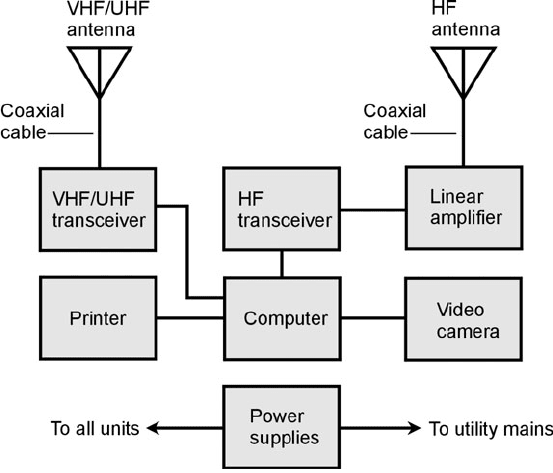
Accessories can be added until a ham “rig” is a large installation, comparable to a small commercial
broadcast station.
Figure 32-5 shows an example of a fixed, computer-controlled amateur radio station. The com-
puter can be used to control the functions of the transceivers, and also to communicate using digi-
tal modes with other hams who own computers. The station can be equipped to interface with the
telephone services, also called landline. The computer can control the antennas for the station, and
can keep a log of all stations that have been contacted.
The best way to learn about ham radio in the United States is to contact the headquarters of the
American Radio Relay League (ARRL), 225 Main Street, Newington, CT 06111. They maintain a
Web site at www.arrl.org. If you live outside the United States, the ARRL can direct you to an or-
ganization in your home country that can help you obtain a license and get on the air.
Shortwave Listening
The high-frequency (HF) portion of the radio spectrum, at frequencies between 3 and 30 MHz, is
sometimes called the shortwave band. This is a misnomer by contemporary standards; the waves are
long compared with ultrahigh frequencies (UHF), microwaves, and IR, which are commonly used
in wireless devices. In free space, a frequency of 3 MHz corresponds to a wavelength of 100 m; 30
MHz corresponds to 10 m. In the early years of radio when the shortwave band got its name, the
wavelengths between 3 and 30 MHz were short compared with the wavelengths of most broadcast
and communications signals, which had wavelengths in the kilometer range.
Anyone can build or obtain a shortwave or general-coverage radio receiver, install a modest out-
door antenna, and listen to signals from all around the world. This hobby is called shortwave listen-
ing or SWLing. In the United States, the proliferation of computers and online communications
has, to some extent, overshadowed SWLing, and many young people grow up today ignorant of a
560 Personal and Hobby Wireless
32-5 A computer-controlled
amateur radio station.
